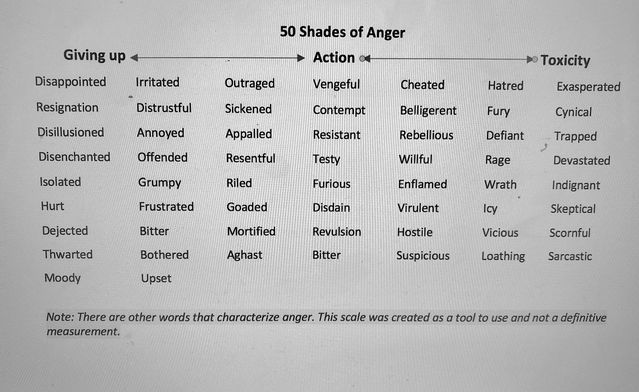The basic emotions of anger, fear, surprise, and disgust are immediate, biological reactions to a situation. Your brain perceives a threat and triggers a reaction to protect you. All humans have these responses; anger, fear, surprise, and disgust are natural reactions similar in all people.
Within seconds or less, your brain then makes meaning of the situation. Based on the story you create, your emotions might expand, defuse, or shift to a social emotion such as contempt, relief, shame, or gratitude. If you initially reacted in anger, what happens next depends on how your emotions migrate.
The Anger Scale ranges from inaction or Giving Up due to a sense of helplessness, to Action by words and behavior, to toxic inaction or Toxicity where you don’t think things will change but you are full of spite that seeps into your words and poisons your body and relationships. You may move in any direction on the scale based on the results of your actions, your current and past experiences, and your sense of possible change.
It is important to identify where you are on the scale to better understand what step will be most useful for you. If you have reached the state of Toxicity, you may need to work on releasing your anger before you decide what to do next.

The first step is to capture the story your brain is telling. You can write this down and ask yourself the questions below. Instead of working on your own, it is more effective to work with a coach or friend who will listen without critique, disagreement, or an urgent desire to tell you what to do. You need to talk to someone who will understand and accept that you feel the way you do, who might help you summarize your story when you start repeating yourself, and who might ask questions to better understand what you mean.
When you talk with someone who holds a safe, non-judgmental space for you to tell your story, you can hear yourself speaking which helps you better understand yourself. This understanding often leads to new, more productive action.
The SET – C Approach
Use these steps to explore what you are experiencing:
- Story – In your point of view, what is causing you to feel the way you do? Don’t edit the story. Blame whomever you want. Complain about what happened, what’s changing, or what failed to change. Declare the injustice. Name the ignorance, the short sidedness, the awful behaviors, the cluelessness, and what is flat out wrong.
- Emotions – Name the emotions you are feeling. Be honest. Scan your body for tenseness and aches. Use the scale above to label all that you think you are feeling.
- Trigger – What did you expect or want to happen that didn’t? What is the loss you feel (i.e. respect, status, acknowledgment, opportunity, regard, acceptance, belonging, safety, hope, value for yourself or your good work)?
Before you take the last step, answer these questions:
- Now that you have told your story, what do you know for sure?
- If there were other explanations for what occurred, what might they be?
- What do you want that you didn’t get? What did you hope would happen?
- What dream was battered or bruised?
- Are you willing to create a new dream, hope, or possibility that is worth fighting for? How would you like this story to end?
- What is the possible future that inspires you to act?
Once you are clear on what outcome you want
4. Choose – To achieve your desired outcome, answer these questions:
- What is the very next thing you could do to achieve your dream? When will you do it?
- Is there anything you need to declare or ask for?
- What were you doing before? What could you change that will help you move forward?
- What do you fear will get in the way? How can you move beyond that fear or concern?
- What emotions will balance your anger, such as passion, hope, love, courage, and faith? How can you shift to feeling one of these emotions when your anger feels out of control or harmful?
- Is there any support you need? Who has a similar dream you can align with?
Anger can be a great motivator of change if you are clear about what you want to create and the purpose behind your decisions. The intensity of your desire for change relates to the likelihood of success even if the victories are small and results take time to achieve.
Don’t let people tell you that anger is bad, unappealing, and dangerous. Anger fuels action. You are more willing to take risks if you don’t fall into resignation or cynicism.
Balance your anger with passion for what you want to achieve, love for those who stand with you, hope for a better future, courage to persist, and faith that good will triumph.
If you keep your vision in mind and you are taking positive steps to realize the change, you can shift your anger into a force for good. That should make you feel proud.
References
Traister, R. (2018). Good and Mad: The Revolutionary Power of Women’s Anger.Simon & Schuster.
Reynolds, M. (2017). Outsmart Your Brain: How to Master Your Mind When Emotions Take the Wheel. Covisioning.
Originally published at Psychology Today
